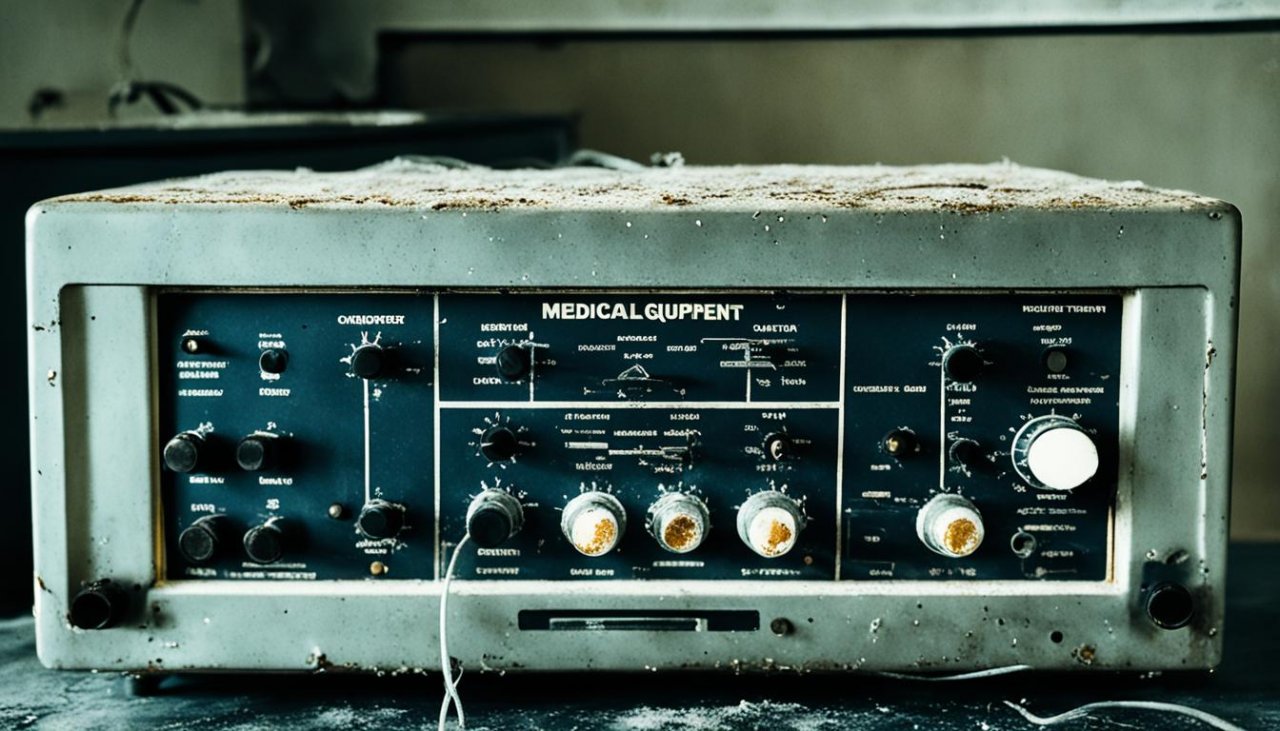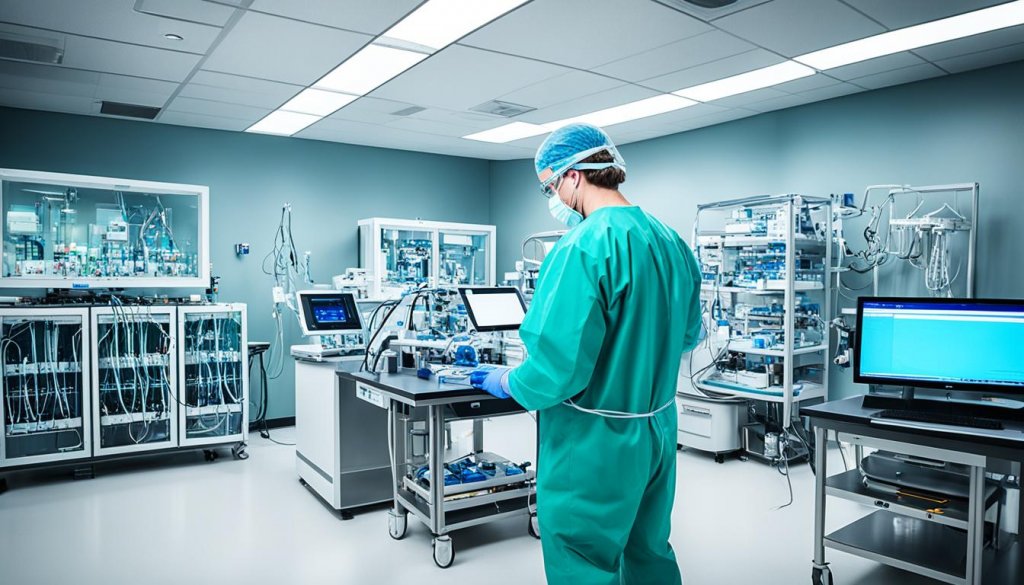Have you ever thought about how a single delay in medical equipment maintenance could affect a patient’s life? The reliability of medical devices is key to safe healthcare. Ensuring timely upkeep can mean the difference between good patient care and serious treatment issues.
With healthcare technology getting more complex, it’s vital to know how to manage and maintain our medical equipment well. This knowledge is crucial for patient safety.
Recent studies show that good maintenance boosts the efficiency of medical machines. For example, out of 502 quality control test monitors, 496 passed their first check. This highlights the importance of regular checks and managing biomedical equipment maintenance well.
Let’s look at key steps we can take to avoid the risks of delayed maintenance. By doing so, we can make sure our medical devices work well when we need them most.

Key Takeaways
- Timely maintenance is key to avoiding equipment failure and keeping patients safe.
- Having a set maintenance schedule can cut costs and reduce delays.
- Training medical staff regularly is crucial to prevent delays in maintaining medical devices.
- Keeping an inventory of equipment makes routine maintenance easier.
- Technology is vital for improving healthcare technology maintenance.
Understanding the Importance of Timely Medical Equipment Maintenance
Keeping medical equipment in good shape is key to quality patient care. I’ve seen how regular checks keep things running smoothly, avoiding problems when they matter most. For example, MRI machines and ventilators are crucial for diagnosing and treating patients. If they break down, it can cost more to fix them and affect patient care.
Having a solid maintenance plan helps these important machines last longer. It’s smart to set aside money each year for keeping devices in top shape. By doing this, I’ve seen fewer big repair bills later on.
With today’s connected healthcare, maintenance needs to change too. It’s vital to keep up with updates for equipment and software to tackle cybersecurity issues. Regular checks boost performance and help make better decisions, keeping care smooth for everyone.
Recognizing the Risks of Delayed Medical Equipment Maintenance
Waiting too long to maintain medical equipment is risky. It can put patients and operations at risk. If equipment isn’t kept up, it might not work when it’s needed most.
This can lead to serious problems like incorrect diagnoses and delays in treatment. In the worst cases, it could even cause harm to patients.
Ignoring maintenance also has a big financial cost. Hospitals might have to spend more on repairs, face downtime, or buy new equipment. This hurts the financial health of healthcare organizations.
By understanding these risks, I can push for better maintenance schedules. This ensures a safer place for both staff and patients.
Common Causes of Medical Equipment Downtime
Knowing why medical equipment goes down is key to keeping patients safe. When equipment fails, it can cost a lot of money and affect treatment results. By understanding what causes downtime, I can prevent these problems.
Age and Wear of Equipment
Old medical devices often break down, making maintenance harder. They work less well and can stop working suddenly. Checking on equipment regularly helps us know when it might fail.
Planning to replace old equipment helps avoid problems in healthcare.
Improper Maintenance Practices
How we maintain medical equipment is very important. Not keeping up with maintenance can cause devices to break. I’ve seen that a regular maintenance plan cuts downtime by a lot.
Fixing maintenance habits helps machines last longer and work better.
Environmental Factors Impacting Equipment
Things like humidity, temperature changes, and cleanliness affect medical devices. Not taking care of waterlines or not sterilizing properly can lead to big problems. Keeping an eye on these things helps make sure equipment works right.

Proactive Strategies for Effective Medical Device Upkeep
Keeping medical equipment in top shape is crucial in healthcare. It ensures patients are safe and keeps operations running smoothly. I use several key practices to keep devices in good condition.
Implementing Preventive Maintenance Programs
Preventive maintenance is key for keeping medical gear running well. It involves regular checks and services to spot problems early. By doing routine maintenance, I can make devices last longer and save on costs.
Studies show that using preventive maintenance can lead to big savings. It helps fix small issues before they turn into big problems.
Creating an Equipment Inventory
Keeping track of medical devices is crucial for managing them well. I keep a detailed list of all my equipment. This lets me plan maintenance based on how old and in what condition each device is.
Knowing when to replace devices helps me plan ahead. Items like generators and anesthesia machines need replacing every 5 to 20 years. Keeping spare parts on hand helps avoid delays due to global shortages.
Regular Training for Medical Staff
Teaching staff how to maintain equipment is very important. Training sessions help them understand the value of keeping devices in good shape. This includes knowing how to spot and fix issues quickly.
Well-trained staff can reduce downtime and keep operations smooth. Regular training builds a culture of maintenance and ensures we follow the rules. This makes our work more efficient.
How to Schedule Routine Inspections and Testing
Scheduling regular checks on medical equipment is key for keeping it safe and working right. Healthcare places should make a plan for upkeep that follows the maker’s advice and their own rules. Having skilled biomedical engineers do these checks helps spot problems early, preventing big issues later.
Keeping medical devices precise and reliable is crucial. I suggest having a detailed log for inspection results. This helps track how well equipment has been doing over time. Such careful tracking helps meet government rules and leads to better patient health and protects against lawsuits.
Inspections should be planned based on time or usage, depending on what the equipment needs. This way, important items like baby incubators and life support machines get the focus they need. Less critical gear can be checked less often, making good use of resources.
Leveraging Technology for Healthcare Technology Maintenance
Technology is key in keeping healthcare equipment in top shape. It makes things run smoother and improves the care quality in hospitals. By using the latest tools, I can make sure medical devices work well and meet the required standards. This helps keep patients safe and makes things run better.
Asset Management Solutions
Asset management solutions help me manage medical devices well. They give me real-time info on what devices we have, where they are, and their maintenance history. With this info, I can plan better for maintenance and use our resources wisely. It also helps me follow the rules that say all maintenance must be done on time for all devices.
Software Updates and Security Measures
Keeping medical devices updated is crucial for their maintenance. It helps protect against cyber threats that hospitals often face. I keep an eye on warnings from U.S. government agencies about ransomware attacks on healthcare systems. By updating software regularly and taking security steps, I help protect patient data and keep the system safe.

Collaboration with Equipment Manufacturers for Optimal Maintenance
Working with equipment manufacturers has greatly improved how we maintain healthcare technology. They give us maintenance plans that fit our needs. Their technical support helps with repairs and upkeep.
Keeping in touch with manufacturers helps us follow their service advice. This keeps our medical devices running well. With supply chain delays, manufacturers stock up on parts to prevent problems. This helps us avoid downtime that could affect patient care.
Many top manufacturers also offer training for our staff. These sessions teach us how to use and maintain equipment right. Using predictive maintenance and new strategies makes our facility more reliable and cuts costs.
Establishing a Contingency Plan for Equipment Downtime
Creating solid contingency plans for medical equipment is key to keeping patient care safe and uninterrupted. When equipment breaks down, it can really disrupt patient care. I focus on putting patients first, setting up quick alert systems, and figuring out why equipment fails.
Being ready means having backup equipment or knowing who to call for fast help. I’ve learned that many healthcare places struggle with sudden equipment failures. This shows we need good plans to lessen the impact on care.
Recording why and how equipment fails helps us react faster and get better over time. Looking into these issues helps us fix our maintenance plans to cut down on future problems. Knowing the costs of downtime helps us make a case for spending on prevention.
With careful planning and analysis, we can make our facility stronger against equipment failures. My aim is to keep patient care steady, even when things go wrong. I want to make sure our patients stay safe and cared for, no matter what.
Conclusion
Preventing delays in medical equipment maintenance is key to keeping patients safe and healthcare running smoothly. It’s important to know the risks of not maintaining equipment right. By using proactive strategies, healthcare providers can cut down on equipment downtime and make their equipment last longer.
Staff training is also vital for keeping healthcare tech in top shape. Training helps staff know how to use and maintain equipment properly. This is crucial for avoiding mistakes and delays in treatment. Working with manufacturers also helps, making sure maintenance meets standards and avoiding fines.
By focusing on avoiding delays in medical equipment maintenance, healthcare groups can offer better care. This leads to better patient outcomes and stronger healthcare systems. It’s about protecting our investments and most importantly, the health and well-being of our patients.
See how FieldAx can transform your Field Operations.
Try it today! Book Demo
You are one click away from your customized FieldAx Demo!
FAQ
Why is timely maintenance of medical equipment essential?
Keeping medical devices in good shape is key for patient safety and care. It helps avoid delays caused by broken equipment. This is crucial for both patient safety and keeping things running smoothly in healthcare settings.
What are the risks associated with delayed medical equipment maintenance?
Waiting too long to fix medical equipment can lead to many problems. These include less efficient operations, risks to patient health, higher repair costs, delays in treatment, and more legal issues.
How can healthcare facilities prioritize maintenance schedules?
To keep up with maintenance, set a schedule that follows the maker’s advice. Regular checks are also a must. This way, healthcare places can manage their equipment well and avoid downtime.
What proactive strategies can be implemented for effective medical device upkeep?
To keep devices in top shape, plan regular checks and train staff well. Working closely with the makers of the equipment helps too. This approach makes maintenance more effective.
What role does technology play in healthcare equipment maintenance?
Technology helps a lot with keeping equipment in check. It offers tools for managing assets, updating software, and keeping devices secure. This ensures they work well and safely.
How can I ensure my medical equipment is regularly inspected?
Make a detailed maintenance plan with checks based on the maker’s advice. Use trained engineers for regular checks and tests. This keeps equipment running right.
What should be included in a contingency plan for equipment downtime?
A backup plan should cover how to keep patients safe first. It should also point out why equipment fails and have spare equipment ready. This ensures services don’t stop.
Author Bio
Co-Founder & CMO at Merfantz Technologies Pvt Ltd | Marketing Manager for FieldAx Field Service Software | Salesforce All-Star Ranger and Community Contributor | Salesforce Content Creation for Knowledge Sharing






